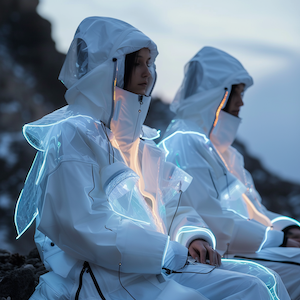

midjourney AI’s imagining of a wearable home; my own prompt
One of my first posts, long-time reader Theresa recently reminded me, was about the idea of us collaboratively designing a ‘wearable home’, an outfit that would be useful to homeless people, migrants (including billions of soon-to-be collapse refugees), purposeful nomads, and anyone who cannot find a comfortable place, or does not want to live in one ‘indoor’ place. My post was sparked by some designs by Mary Mattingly, a NYC designer, who continues to promote and support the idea — building on the original vision of creating what might be described as human ‘cocoons’.
Here is the specification I came up with way back then after reviewing Mary’s work:
- It would be comfortable and allow full freedom of movement in any weather conditions.
- It would be, if not fashionable, at least not ridiculous-looking.
- It would incorporate the portable communication, information and entertainment technologies that we now take for granted, built-in, without having to carry around bulky or heavy ‘peripherals’ (this may be more a ‘nice to have’ than a ‘need to have’).
- It would allow us to see and function in the dark, using either built-in lighting or some other optical technology.
- It would be either easy to clean or keep clean, or, like some new hospital curtains and garments, self-cleaning.
- It would be comfortable enough to sleep in, ideally without the need for bedding, perhaps using some kind of inflatable inner lining.
- It would be customizable both stylistically (we don’t all want to look the same) and functionally (e.g. temperature could be regulated to climate and personal preferences).
- It would not replace the need for a place to store and cook food, but might obviate the need for every room in the modern ‘single family home’ except the kitchen and bathroom.
ChatGPT summarizes Mary’s ideas as follows:
The idea involves creating portable and wearable structures that function as a personal living space, allowing individuals to carry their shelter with them. The wearable home is a response to issues such as housing instability, environmental concerns, and the desire for personal autonomy.
Key features and concepts associated with Mary Mattingly’s wearable home include:
-
- Mobile Shelter: The wearable home is designed to be a mobile and compact living space that individuals can wear or carry, providing a sense of home and security wherever they go. It is a response to the changing nature of living and the need for adaptable solutions.
- Sustainable Design: Mattingly’s projects often incorporate sustainable and eco-friendly design principles. The wearable home concept may involve materials and technologies that minimize environmental impact, aligning with Mattingly’s broader focus on ecological and social issues.
- Autonomy and Flexibility: The wearable home allows for a degree of autonomy and flexibility in living arrangements. It acknowledges the transient nature of contemporary life and provides a solution for those who may not have a fixed or permanent place of residence.
Since I wrote the original article, Vinay Gupta has invented a portable structure called a Hexayurt, which has apparently become a ‘thing’ at Burning Man festivals. Last year he introduced a one-personal foldable, transportable variant, and also began a project to develop a military-design garment called a woobie for use by, well, anyone looking for a piece of clothing you can live in regardless of the weather, which he hopes to eventually distribute to refugees and the homeless. You can buy one and try it on, from a link on his site (but minimum order is 10 woobies, so you’ll have to organize some others). He’s hoping buyers will work with the Chinese manufacturer to refine and expand the design.
There are of course all kinds of alternatives to Hexayurts if you’re looking for four (or six) walls and a roof that are inexpensive but more comfortable and durable than tents. The ‘glamping’ (=glamorous camping) community offers plenty of imaginative options. School buses and shipping containers have been converted into tiny homes, and many organizations now offer tiny home designs that are (more) affordable, and sometimes even transportable.
But what if we want to get back to absolute basics, and not have to add the complication of walls and roofs? Is there a ‘wearable home’ that works as well as the centuries-old ‘perfect house’ of the Ihalmiut peoples of the arctic? Sportwear companies and workwear companies have done some innovation, but their garments seem designed for temporary use addressing specific extreme weather challenges, not for all-weather, every-day use. And refugee organizations are too busy dealing with the immediate challenges of their case-loads to have time for innovating.
A Dutch designer has made a Sheltersuit, and a companion padded Shelterbag for homeless sleeping, but they’re pretty dreadful-looking — but they’ve made 12,500 of them, manufactured by 100 homeless people in the Netherlands. (There’s a similar organization in the US that makes something called the EMPWR coat.) The Australians developed the swag, their ‘backpack bed’ that includes a pad, a weatherproof cover or tarp, and insect netting — a (usually pole-less) 18″-high tent, sleeping bag and mattress, all in one. But it’s something that must be carried, rather than worn.
My sense is that, if we really want to find innovative solutions to the ‘wearable home’ challenge, we’d probably be best to look to existing indigenous, transient and homeless populations around the world, who have had to find solutions on their own. That’s how Farley Mowat learned about the Ihalmiuts’ ‘perfect house’.
That would mean that, before we rush to high-tech solutions, we might want to do a bit of cultural anthropology among peoples who’ve had no choice but to find ‘wearable homes’ of their own, or their communities’, invention. There’s a lot of hard research that would need to be done, looking humbly at what’s been tried, and why it has, or hasn’t, worked.
But it might be worth it. There could, one day in the not-too-distant future, be a couple of billion semi-nomadic customers looking for a way to make their lives more bearable. Looking for a wearable home — the ‘perfect house’.




